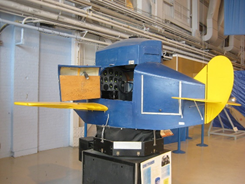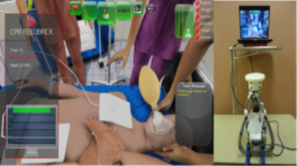The future of simulation in medical instruction
By Maxwell Delamere-Sanders
Perhaps the first thing that comes to mind when you think of simulations is the flight simulator, maybe something like the Link Trainer (pictured in Figure 1). Flight training is well suited to simulation, as it is potentially dangerous and involves expensive hardware. The medical profession shares – and surpasses – these risks, making it fertile ground for simulation-based education. From antiquity, medical simulation used clay, stone or wood mannequins to allow students to practice medical procedures safely, as described by Meller.

Modern medical simulation still uses mannequins (though stone and clay have been replaced by silicone and circuitry) as well as virtual simulations. Most medical education institutions employ some form of both of these modalities of simulation as described by May. Multiple studies have demonstrated the effectiveness of simulation for medical education, such as those conducted by Underwood and McKinney. Fidelity refers to how closely a simulation resembles the real-world experience it aims to simulate. New materials and technology for mannequins have dramatically increased their fidelity in the last thirty years. Virtual reality is experiencing a similar boom in recent years as computer horsepower and rendering techniques come closer to matching the real operating room (OR).
To VR or not to VR
Developing training for medical professionals today means choosing an approach out of a large and varied toolbox. Virtual Reality (VR) is one of these tools and its appeal is only growing. VR is a cost-effective and versatile alternative to expensive mannequins or specialized trainers. The main barrier to VR replacing other simulation methods has long been fidelity, as described by Satava. However, fidelity seems to have a limited effect on learning outcomes as found by Yang. Isaranuwatchai evaluated the cost effectiveness of a series of training methodologies: VR, high fidelity mannequin and progressive (VR and mannequin). They found that, depending on the funds available for investment in training programs, VR provides good return on investment in terms of learning outcomes.
Just as medical training mannequins experienced a significant leap in fidelity in the 1990s with the improvement of materials available and computer hardware and software for information gathering and feedback as described by Meller and Cooper, VR is in the nascent stages of a similar revolution. Stronger computer hardware and rendering techniques, as well as commercially available, affordable VR hardware herald a new age for VR as described by Rothman. The technology exists for high-fidelity medical training simulations, but the investment does not. Even the most recent simulations lag behind video games for entertainment in fidelity by at least a decade.
A VR Simulation for Advanced Cardiac Life Support (ACLS) Training

Vankipuram and colleagues have taken a step toward closing this gap. They have developed a VR simulation for cardiac life support training using a modern game engine (UnrealEngine), VR headsets and customized input devices (see figure 2). Networking allows students to work together, each filling a role on the trauma team. A customized UI provides real-time feedback on performance, while detailed data is gathered for evaluation and debriefing by an instructor. One of the biggest advantages of VR simulations over their practical counterparts is their ability to record large amounts of detailed information. Traditional mannequin simulations rely on the instructor to observe and provide feedback on each team member’s individual performance, while VR simulations can record every detail of every action of each team member.
Remote Facilitation
Another benefit of VR simulations for medical training is the potential for remote facilitation. Availability of specialized facilitators can be a major impediment to effective medical instruction. Ohta and colleagues compared a remotely facilitated, VR simulation-based pediatric resuscitation training module for medical students with the same program facilitated locally. They found no significant difference in learning outcomes for the remote facilitator versus the local one. Remote facilitation has the potential to greatly improve access to high-quality instructors in specialized fields across institutions at lower cost and with greater flexibility than requiring an in-person facilitator.
Next Steps
This work is a step in the right direction, but greater investment in the development of high-fidelity VR simulations for medical training is needed. The role of fidelity in the effectiveness of medical simulations is disputed. Yang and colleagues found no correlation between fidelity and effectiveness, while Isaranuwatchai and colleagues found that high-fidelity mannequins provide some improvement to learning outcomes over low-fidelity VR simulations. As VR simulations improve, more research is required to compare their effectiveness with more traditional methods of instruction, especially high-fidelity mannequins.
Remote facilitation has long been touted as the future of education. With the advent of reliable, fast internet connections and high-fidelity VR and the sense of presence it provides, remote facilitation is becoming more feasible. The future of medical education is virtual.
References
Christensen, M., Tan, S., Rieger, K., Dieckmann, P., Oestergaard, D., & Watterson, L. (2013). A Comparison of the Relative Effectiveness of Remotely and Locally Facilitated Simulation-Based Training of Medical Emergencies by Postgraduate Healthcare Teams. Simulation in Healthcare: The Journal of the Society for Simulation in Healthcare, 8(6), 526.
Cooper, J. B., & Taqueti, V. R. (2008). A brief history of the development of mannequin simulators for clinical education and training. Postgraduate Medical Journal, 84(997), 563-570.
Underwood, L., Ginkel, C. V., Lee, D., Wong, M., Dizaiy, S., Fry-Bowers, E., Nguyen, H. (2008). 153: Effectiveness of Medical Simulation on Knowledge in Septic Shock Management During Pre- Clinical Medical Training. Annals of Emergency Medicine, 51(4), 517.
Dotson, M. P., Gustafson, M. L., Tager, A., & Peterson, L. M. (2018). Air Medical Simulation Training: A Retrospective Review of Cost and Effectiveness. Air Medical Journal, 37(2), 131-137.
Fletcher, J. D., & Wind, A. P. (2013). Cost Considerations in Using Simulations for Medical Training. Military Medicine, 178(10S), 37-46.
Isaranuwatchai, W., Brydges, R., Carnahan, H., Backstein, D., & Dubrowski, A. (2013). Comparing the cost-effectiveness of simulation modalities: A case study of peripheral intravenous catheterization training. Advances in Health Sciences Education, 19(2), 219-232.
Lin, W., & Song, Y. (2017). Effectiveness of different numbers of simulation training models on medical students’ cervical examination performance. International Journal of Gynecology & Obstetrics, 141(2), 255-260.
Mckinney, J., Cook, D. A., Wood, D., & Hatala, R. (2012). Simulation-Based Training for Cardiac Auscultation Skills: Systematic Review and Meta-Analysis. Journal of General Internal Medicine,28(2), 283-291.
Meller, G. (1997). A typology of simulators for medical education. J Digit Imaging, 10(3), 194-196.
Ohta, K., Kurosawa, H., Shiima, Y., Ikeyama, T., Scott, J., Hayes, S., Nishisaki, A. (2017). The Effectiveness of Remote Facilitation in Simulation-Based Pediatric Resuscitation Training for Medical Students. Pediatric Emergency Care, 33(8), 564-569.
Rothman, J. (2018, April 2). Are We Already Living in Virtual Reality? The New Yorker.
Satava, R. (2013). Keynote speaker: Virtual reality: Current uses in medical simulation and future opportunities & medical technologies that VR can exploit in education and training. 2013 IEEE Virtual Reality (VR).
Vankipuram, A., Khanal, P., Ashby, A., Vankipuram, M., Gupta, A., Drummgurnee, D., Smith, M. (2014). Design and Development of a Virtual Reality Simulator for Advanced Cardiac Life Support Training. IEEE Journal of Biomedical and Health Informatics, 18(4), 1478-1484.
Yang, C., Wang, H., Chou, E. H., & Ma, M. H. (2012). Fidelity does not necessarily result in effectiveness – A randomized controlled study in a simulation-based resuscitation training for medical students. Resuscitation, 83.
Maxwell Delamere-Sanders is a student in the Seneca Technical Communication Certificate Program at Seneca College. He completed a degree in English and Psychology at the University of Toronto in 2016, and is excited to bring his passion for language and the human mind to bear on the field of technical communication.

